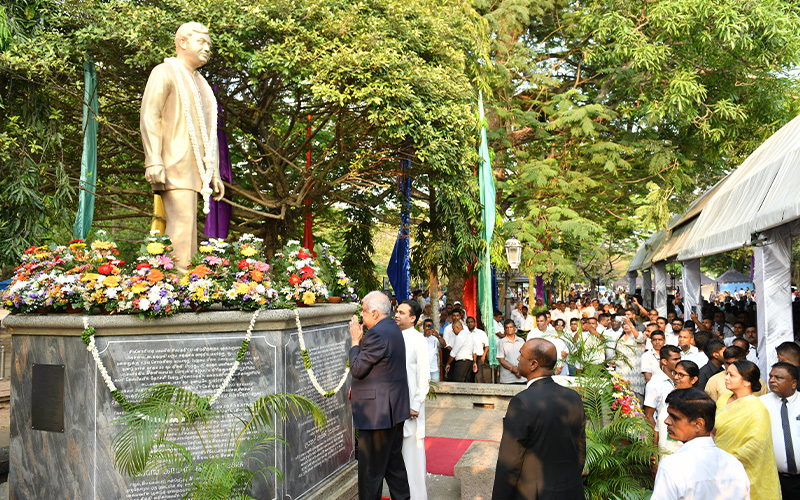
Sri Lanka’s president Ranil Wickremesinghe paid tribute to the late UNP minister Gamini Dissanayake last month, pledging to expand the controversial Mahaweli project, which has seen Sinhala settlers colonise the Tamil North-East.
The project, which began under the UNP government of 1977, was one of many state-sponsored colonisation projects that took place in the Tamil North-East. Wickremesinghe said the A and B zones of the Mahaweli region could not be developed, a key facet of which includes the construction of Sri Lanka’s most expensive and longest waterway.
Wickremesinghe went on to lay a floral tribute before a statue of Dissanayake stating his “his dedication serves as an exemplary model for all”.
Former Speaker Karu Jayasuriya also addressed the gathering, speaking of Dissanayake ‘s “popularity and service to the people”.
Speaking on the colonisation projects at the time, Dissanayake had said “We have decided to colonise four districts including Mannar with Sinhalese people by destroying forests. A majority of Sinhalese will be settled there. If you like you also can migrate there.” (See more on state sponsored colonisation here.)
Dissanayake was one of several high profile Sri Lankan leaders in Jaffna, whilst soldiers burnt down the Jaffna Library and the tens of thousands of rare manuscripts it housed in an act that has been described as cultural genocide.
The destruction took place under the rule of the UNP at a time when District Development Council elections were underway, and two notorious Sinhala chauvinist cabinet ministers - Cyril Mathew and Dissanayake - were in Jaffna.
Nancy Murray, a western author, wrote at the time ''uniformed security men and plainclothes thugs carried out some well organised acts of destruction”.
"They burned to the ground certain chosen targets - including the Jaffna Public Library, with its 95,000 volumes and priceless manuscripts…no mention of this appeared in the national newspapers, not even the burning of the library, the symbol of Tamils' cultural identity. The government delayed bringing in emergency rule until 2 June, by which time the key targets had been destroyed."
The burning continued unchecked for two nights.
Sri Lanka’s former president R Premadasa would later claim Dissanayake and other UNP leaders were responsible.
In 1983, just two years later, he once more would come to the fore, accused of instigating anti-Tamil pogroms and the murder of Tamils, weeks before the Black July massacres were to take place.
See an extract from "Sri Lanka - 'Paradise' in Ruins," (Sri Lanka Co-ordination Centre, Kassel, 1983) below.
The town was closely guarded by the army. All vehicles were checked. Bus conductors had orders not to transport Tamils. Minister Gamini Dissanayake came from Colombo to Nuwara Eliya to hold a meeting with party members. The day before, M.P. Herath Ranasinghe had arrested precautiously (sic) some well-known rowdies. Soon after the end of Gamini Dissanayake's party meeting they were released.
These people went out immediately, well-equipped with petrol, iron rods and other kinds of weapons, and tried to attack two Tamil priests in town. They managed to escape. Without having succeeded they moved on - another mob joined up with the first one. They laid a ring of petrol around a Tamil shop which was then burnt. They were supported in this by the army who supplied them with gallons of petrol. During the day nearly all Tamil-owned shops were burnt. Mrs. Herath Ranasinghe ordered the army to disperse the looters - but it was already too late. The Member of Parliament was banished from town under a hail of insults. Tamil people who walked the streets were beaten by soldiers. The fire brigade which stood waiting was hindered by the army and the Sinhalese mob in doing its job... Shops which had not been burnt by the mob were set fire to by the army. Around noon Nuwara Eliya was like a sea of flames.
In a widely reported speech on 5 September 1983, Dissanayake said,
''Who attacked you? Sinhalese. Who protected you? Sinhalese. It is we who can attack and protect you.
They are bringing an army from India. It will take 14 hours to come from India. In 14 minutes, the blood of every Tamil in the country can be sacrificed to the land by us.
It is not written on anyone's forehead that he is an Indian or a Jaffna Tamil, a Batticaloa Tamil or upcountry Tamil, Hindu Tamil or Christian Tamil. All are Tamils.''
Dissanayake was assassinated in 1994.
